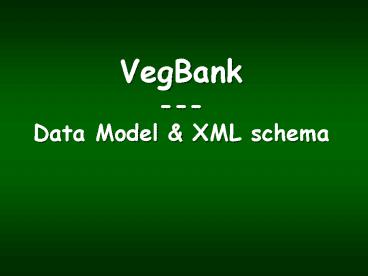VegBank Data Model - PowerPoint PPT Presentation
1 / 34
Title: VegBank Data Model
1
VegBank ---Data Model XML schema
2
We are pleased to acknowledge the support and
cooperation of
3
Why an exchange standard?
- Many research questions require lots of data
- Facilitate exchange !
- Write input/output just once
- Encourage others to participate (eg US Forest
Service) - Safe documented long-term storage of plot data
4
www.vegbank.org
5
- T
6
- T
7
(No Transcript)
8
- Key design features
- Many kinds of plots !!!
- Easy search
- Easy citation and linkage
- Easy download
- XML input and output options
- Users can annotate plots and determinations
- Support of taxon concepts
9
Biodiversity data structure
Vegetation Type
Vegetation type database
10
Core elements of VegBank
Project
Plot
Plot Observation
Taxon / Individual Observation
Taxon Interpretation
Plot Interpretation
11
- VegBank consists of three integrated databases
- The Plot Database
- The Plant Database
- The Community Database
12
The VegBank ERD
- Available at http//vegbank.org/vegdocs/design/e
rd/vegbank_erd.pdf - Click tables for data dictionary and constrained
vocabulary
13
(No Transcript)
14
- Plot
- Embargos
- Named Place
15
- Observation
- Project
- Disturbance Obs
- Soil Obs
- Soil taxon
- Graphic
- Observation Synonym
16
- Taxon Observation
- Importance values
- Author name
- Taxon Interpretation
- Which taxon
- Who decided and why
- Stem or collective
- Voucher information
17
(No Transcript)
18
- Strata Cover
- Stratum method
- Stratum type
- Stratum
- Cover method
- Cover Index
19
- Interpretationcontinued
- Plants
- Tax Interpretation
- Taxon Alt
- Communities
- Class
- Interpretation
20
Problematic taxa of ecological datasets
- Carex sp.
- Crustose lichen
- Hairy sedge 6.
- Sporobolus sp. 1
- Picea glauca engelmannii complex
- Potentilla simplex or P. canadensis
- Carya ovata sec. Gleason 1952
21
- Party
- Project Contr.
- Obs Contr.
- Role
22
References
23
- Utilities
- User defined
- Notes
- Revisions
24
(No Transcript)
25
Taxonomic database challengeStandardizing
organisms and communities The problem
Integration of data potentially representing
different times, places, investigators and
taxonomic standards. The traditional solution
A standard list of organisms / communities.
26
- Standardized taxon lists fail
- to allow dataset integration
- The reasons include
- Taxonomic concepts are not defined (just lists),
- Relationships among concepts are not defined
- The user cannot reconstruct the database as
viewed at an arbitrary time in the past, - Multiple party perspectives on taxonomic concepts
and names cannot be supported or reconciled.
27
Three concepts of subalpine fir Splitting one
species into two illustrates the ambiguity often
associated with scientific names.
Abies bifolia
Abies lasiocarpa
Abies lasiocarpa
sec. Little sec. USDA PLANTS
sec. Flora North America
28
One concept ofAbies lasiocarpa
USDA Plants ITIS Abies lasiocarpa var.
lasiocarpa var. arizonica
29
A narrow concept of Abies lasiocarpa
Flora North America Abies lasiocarpa Abies
bifolia
Partnership with USDA plants to provide plant
concepts for data integration
30
High-elevation fir trees of western North
America
AZ NM CO WY MT AB eBC wBC WA OR
Distribution
Abies lasiocarpa var. arizonica
Abies lasiocarpa var. lasiocarpa
USDA - ITIS
Abies lasiocarpa
Abies bifolia
Flora North America
A
B
C
Minimal concepts
31
Andropogon virginicus complex in the Carolinas 9
elemental units 17 base concepts, 27 scientific
names
32
Relationships among conceptsallow comparisons
and conversions
- Congruent, equal ()
- Includes (gt)
- Included in (lt)
- Overlaps (gtlt)
- Disjunct ()
- and others
33
- Party Perspective
- The Party Perspective on a concept includes
- Status Standard, Nonstandard, Undetermined
- Correlation with other concepts Equal,
Greater, Lesser, Overlap, Undetermined. - Start Stop dates for tracking changes
34
Intended functionality
- Organisms are labeled by reference to concept
(name-reference combination), - Party perspectives on concepts and names can be
dynamic, but remain perfectly archived, - User can select which party perspective to
follow, - Different names systems are supported,
- Enhanced stability in recognized concepts by
separating name assignment and rank from concept.































